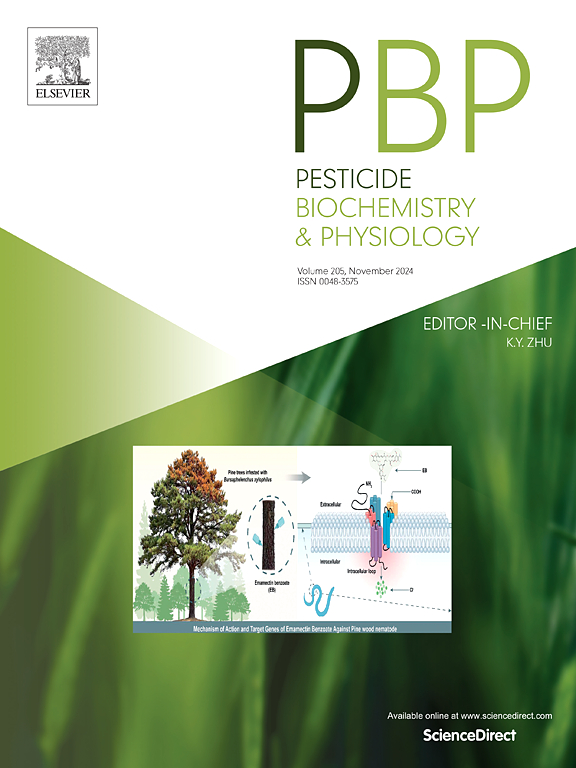5-氨基吲哚通过抑制棘球蚴TPS活性抑制棘球蚴幼虫生长和几丁质合成
IF 4.2
1区 农林科学
Q2 BIOCHEMISTRY & MOLECULAR BIOLOGY
引用次数: 0
摘要
海藻糖-6-磷酸合成酶(trehalose -6-phosphate synthase, TPS)是昆虫体内催化海藻糖生物合成的关键酶,其与海藻糖代谢相关的多种功能已被证实。相比之下,对昆虫TPS抑制剂的研究较少受到关注。此前有报道称5-氨基吲哚对结核分枝杆菌的TPS有较强的抑制作用,但对昆虫的TPS是否有抑制作用尚不清楚。本文主要研究了5-氨基吲哚对农林业多食害虫美国棘球蚴(Hyphantria cunea)幼虫TPS活性的抑制作用。同时,鉴定了该害虫的HcTPS,并评价了5-氨基吲哚对其幼虫生长发育、海藻糖代谢、特别是几丁质合成的影响。生物信息学分析表明,HcTPS编码一个包含401个氨基酸残基的蛋白,包含一个GT20_TPS结构域(18-377),属于糖基转移酶家族20。生物测定结果表明,5-氨基吲哚能显著抑制美洲圆叶蝉幼虫体内TPS活性,降低其体内碳水化合物水平,导致其生长停滞和高致死率。同时,5-氨基吲哚显著下调了几丁质生物合成途径关键基因(HcG6PI、HcGFAT、HcGNA、HcPAGM、HcUAP、HcCHSA)的表达,破坏了小蠊幼虫表皮几丁质生物合成。同源建模和分子对接表明,5-氨基吲哚通过与残基S23、R25和D176形成氢键,并与残基N24、L48和D176形成疏水相互作用,与HcTPS蛋白具有很强的结合亲和力(BE =−4.31 kcal/mol)。此外,5-氨基吲哚还与其他4种昆虫的TPS蛋白具有较强的结合亲和力,包括Helicoverpa armigera、Drosophila melanogaster、Anoplophora glabripennis和Vespula germanica。这些发现为吲哚衍生物作为昆虫TPS抑制剂在害虫防治中的潜在应用提供了新的思路。本文章由计算机程序翻译,如有差异,请以英文原文为准。

5-aminoindole restrained larval growth and chitin biosynthesis via depressing TPS activity in Hyphantria cunea
Trehalose-6-phosphate synthase (TPS) is a key enzyme responsible for catalyzing the biosynthesis of trehalose in insects, and its multiple functions related to trehalose metabolism have been well established. In contrast, research on insect TPS inhibitors has received less attention. Previously 5-aminoindole had been reported to possess a potent inhibition on the TPS of Mycobacterium tuberculosis, but it is not clear whether it has an inhibitory effect on insect TPS. Here, we focused on the role of 5-aminoindole in inhibiting TPS activity of Hyphantria cunea larvae, a polyphagous pest in agriculture and forestry. In parallel, the HcTPS was identified from the pest, and the influences of 5-aminoindole on larval growth and development, trehalose metabolism, especially chitin synthesis were evaluated. Bioinformatics analysis indicated that HcTPS encoded a protein of 401 amino acids residues, which contained a GT20_TPS domain (18–377), belonging to glycosyltransferase family 20. The bioassay indicated that 5-aminoindole significantly suppressed in vivo TPS activity and reduced carbohydrate levels in H. cunea larvae, resulted in growth arrest and a high lethality. Meanwhile, 5-aminoindole significantly downregulated the expression of key genes in the chitin biosynthesis pathway (HcG6PI, HcGFAT, HcGNA, HcPAGM, HcUAP, and HcCHSA), and disrupted chitin biosynthesis in epidermis of H. cunea larvae. Homologous modeling and molecular docking revealed that 5-aminoindole had a potent binding affinity (BE = −4.31 kcal/mol) with HcTPS protein via forming a hydrogen bond with residue S23, R25 and D176, and hydrophobic interactions with the residue N24, L48 and D176. In addition, 5-aminoindole also had a strong binding affinity with the TPS proteins of other four insect species, including Helicoverpa armigera, Drosophila melanogaster, Anoplophora glabripennis, and Vespula germanica. These findings provided a new insight into potential application of indole derivatives as insect TPS inhibitor for pest control.
求助全文
通过发布文献求助,成功后即可免费获取论文全文。
去求助
来源期刊
CiteScore
7.00
自引率
8.50%
发文量
238
审稿时长
4.2 months
期刊介绍:
Pesticide Biochemistry and Physiology publishes original scientific articles pertaining to the mode of action of plant protection agents such as insecticides, fungicides, herbicides, and similar compounds, including nonlethal pest control agents, biosynthesis of pheromones, hormones, and plant resistance agents. Manuscripts may include a biochemical, physiological, or molecular study for an understanding of comparative toxicology or selective toxicity of both target and nontarget organisms. Particular interest will be given to studies on the molecular biology of pest control, toxicology, and pesticide resistance.
Research Areas Emphasized Include the Biochemistry and Physiology of:
• Comparative toxicity
• Mode of action
• Pathophysiology
• Plant growth regulators
• Resistance
• Other effects of pesticides on both parasites and hosts.

 求助内容:
求助内容: 应助结果提醒方式:
应助结果提醒方式:


